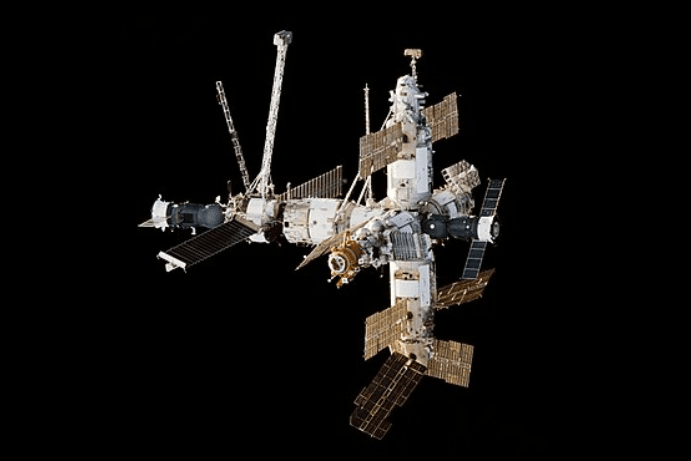On this day, February 19, 1986, a new era of human space exploration began with the launch of the Mir Space Station’s first module. The Soviet Union, known for its ambitious space endeavors, sent Mir into orbit, marking the beginning of what would become one of the most significant and longest-serving space stations in history.
Mir wasn’t just another satellite in the sky; it was a statement of Soviet ingenuity, resilience, and vision. This space station would go on to host numerous astronauts and cosmonauts from around the world, paving the way for the future of space habitats—including the International Space Station (ISS).
But how did this colossal feat of engineering come to be? And what made Mir so special? Let’s travel back in time and uncover the story of the Soviet dream that reached the stars.
The Soviet Union’s Bold Move
By the 1980s, the Soviet Union had already established itself as a space pioneer. It launched Sputnik (the first artificial satellite) in 1957, sent Yuri Gagarin (the first human in space) in 1961, and built Salyut—a series of space stations that tested the possibilities of long-term human habitation in orbit.
However, the Soviets were not satisfied. They wanted something bigger, more advanced, and more enduring—a space station that could support long-duration missions and expand over time. Thus, Mir (meaning ‘peace’ or ‘world’ in Russian) was born. Unlike its predecessors, Mir was designed as a modular space station, meaning new modules could be added over time, making it more flexible and expandable.
On February 19, 1986, at 21:28 Moscow Time, the Soviet Union launched Mir’s first core module aboard a Proton rocket from the Baikonur Cosmodrome. The module contained life support systems, a control center, and living quarters—a home in space for future cosmonauts (Russian astronauts).
What Made Mir Revolutionary?
Mir wasn’t just another space station—it redefined human spaceflight. Here’s what made it stand out:
1. First Modular Space Station
Unlike the earlier Soviet Salyut stations, which were single-piece structures, Mir grew over time. Additional modules were docked between 1987 and 1996. Furthermore, expanded its capabilities and allowed for more scientific research.
2. The Longest Human Spaceflights
Mir set records for human endurance in space. Russian cosmonaut Valeri Polyakov lived on Mir for 438 days (over 14 months!). Valeri’s record still stands today. This mission provided crucial insights into the effects of long-duration space travel on the human body—a key factor in planning missions to Mars.
3. International Cooperation, Despite Cold War Tensions
Even though Mir was a Soviet project, it eventually became a symbol of international collaboration. After the Cold War ended, NASA astronauts started flying to Mir as part of the Shuttle-Mir program (1994–1998). This partnership laid the groundwork for future multinational space projects like the International Space Station (ISS).
4. A Space Lab for Groundbreaking Science
Scientists aboard Mir conducted thousands of experiments in physics, biology, medicine, and astronomy. They studied how plants grow in microgravity, how materials behave in space, and even researched how the human body adapts to prolonged weightlessness—all critical for future deep-space missions.
The Challenges and the End of Mir
As groundbreaking as Mir was, it wasn’t without its challenges.
- By the late 1990s, Mir was showing signs of wear. Frequent system failures, air leaks, and power shortages made operations increasingly difficult.
- One of the scariest moments in Mir’s history occurred when an oxygen generator caught fire in 1997 and filled the station with smoke. Cosmonauts managed to control the situation, but it was a wake-up call about the station’s deteriorating condition.
- A Russian Progress cargo spacecraft accidentally crashed into Mir’s Spektr module, causing depressurization in 1997. The damaged module had to be sealed off permanently.
Mir was deemed too expensive to maintain and its resources were diverted to the new International Space Station (ISS). On March 23, 2001, the legendary space station’s fate was sealed. It was deorbited and burned up in Earth’s atmosphere over the Pacific Ocean.
Mir’s Legacy: A Giant Leap Toward the Future
Although Mir is no longer orbiting Earth, its influence lives on. Many technological lessons learned from Mir were directly applied to the ISS, which remains humanity’s home in space today.
Here’s how Mir shaped the future:
- It proved long-term human space habitation was possible.
- Mir had set records that remain unbroken, like the longest single human spaceflight.
Today, space agencies worldwide—including NASA, Roscosmos, ESA, and private companies like SpaceX—are developing plans for deep-space exploration. Mars missions, lunar bases, and commercial space stations are all part of the next chapter in spaceflight, and none of it would have been possible without Mir.
Conclusion: The Dream That Reached Beyond Borders
Mir was more than just a Soviet achievement—it was a triumph for all of humanity. It taught us that living in space for extended periods is possible, that science can flourish beyond Earth, and that even rivals can work together for the sake of exploration.
As we celebrate February 19, the day Mir’s journey began, let’s remember the station that redefined spaceflight and laid the foundation for our future in the cosmos.
The Soviet dream of Mir didn’t just reach space—it became a stepping stone to the stars.

